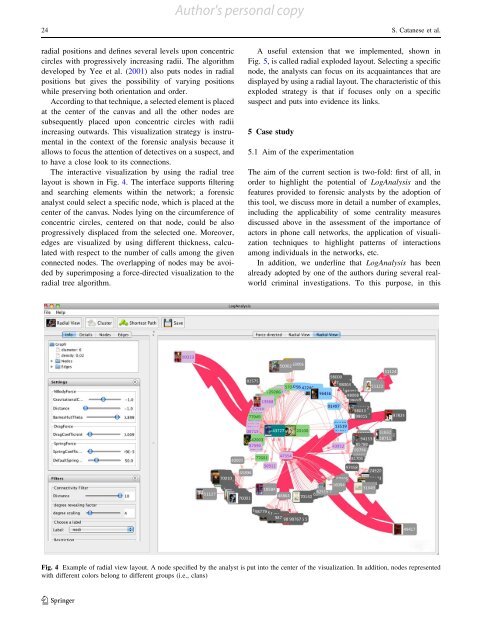Forensic analysis of phone call networks Salvatore Catanese, Emilio ...
Forensic analysis of phone call networks Salvatore Catanese, Emilio ...
Forensic analysis of phone call networks Salvatore Catanese, Emilio ...
Create successful ePaper yourself
Turn your PDF publications into a flip-book with our unique Google optimized e-Paper software.
24 S. <strong>Catanese</strong> et al.<br />
radial positions and defines several levels upon concentric<br />
circles with progressively increasing radii. The algorithm<br />
developed by Yee et al. (2001) also puts nodes in radial<br />
positions but gives the possibility <strong>of</strong> varying positions<br />
while preserving both orientation and order.<br />
According to that technique, a selected element is placed<br />
at the center <strong>of</strong> the canvas and all the other nodes are<br />
subsequently placed upon concentric circles with radii<br />
increasing outwards. This visualization strategy is instrumental<br />
in the context <strong>of</strong> the forensic <strong>analysis</strong> because it<br />
allows to focus the attention <strong>of</strong> detectives on a suspect, and<br />
to have a close look to its connections.<br />
The interactive visualization by using the radial tree<br />
layout is shown in Fig. 4. The interface supports filtering<br />
and searching elements within the network; a forensic<br />
analyst could select a specific node, which is placed at the<br />
center <strong>of</strong> the canvas. Nodes lying on the circumference <strong>of</strong><br />
concentric circles, centered on that node, could be also<br />
progressively displaced from the selected one. Moreover,<br />
edges are visualized by using different thickness, calculated<br />
with respect to the number <strong>of</strong> <strong>call</strong>s among the given<br />
connected nodes. The overlapping <strong>of</strong> nodes may be avoided<br />
by superimposing a force-directed visualization to the<br />
radial tree algorithm.<br />
A useful extension that we implemented, shown in<br />
Fig. 5, is <strong>call</strong>ed radial exploded layout. Selecting a specific<br />
node, the analysts can focus on its acquaintances that are<br />
displayed by using a radial layout. The characteristic <strong>of</strong> this<br />
exploded strategy is that if focuses only on a specific<br />
suspect and puts into evidence its links.<br />
5 Case study<br />
5.1 Aim <strong>of</strong> the experimentation<br />
The aim <strong>of</strong> the current section is two-fold: first <strong>of</strong> all, in<br />
order to highlight the potential <strong>of</strong> LogAnalysis and the<br />
features provided to forensic analysts by the adoption <strong>of</strong><br />
this tool, we discuss more in detail a number <strong>of</strong> examples,<br />
including the applicability <strong>of</strong> some centrality measures<br />
discussed above in the assessment <strong>of</strong> the importance <strong>of</strong><br />
actors in <strong>phone</strong> <strong>call</strong> <strong>networks</strong>, the application <strong>of</strong> visualization<br />
techniques to highlight patterns <strong>of</strong> interactions<br />
among individuals in the <strong>networks</strong>, etc.<br />
In addition, we underline that LogAnalysis has been<br />
already adopted by one <strong>of</strong> the authors during several realworld<br />
criminal investigations. To this purpose, in this<br />
Fig. 4 Example <strong>of</strong> radial view layout. A node specified by the analyst is put into the center <strong>of</strong> the visualization. In addition, nodes represented<br />
with different colors belong to different groups (i.e., clans)<br />
123<br />
Author's personal copy



